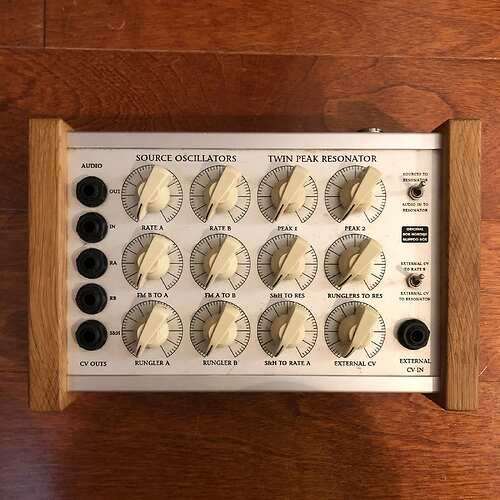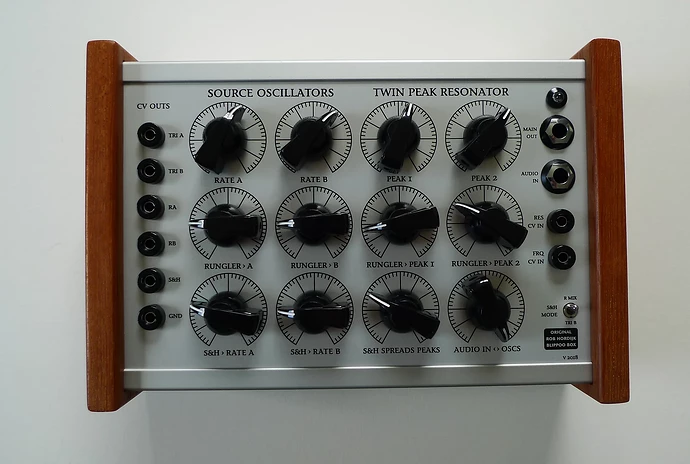NOTE 1401025: the final version is found [here]
I have made a patch emulating the legendary Blippoo Box by Rob Hordijk. You can find a link below. It uses some paid modules, so it is not entirely free. You can check the list of used modules below as well in a separate txt file. Maybe you can replace most of them, if you want a completely free version. Most of the paid modules are in the Post FX chain, so you can leave this out as well.
A lot of info on how the box is made is in this article:
Hordijk Rob (2009) The Blippoo Box - A Chaotic Electronic Music Instrument, Bent by Design.pdf (2.5 MB)
I would love to have a hardware version… but they are very rare, so I settled on this emulation.
The Blippoo Box is the big brother of the Benjolin: It has also a chaotic 2 oscillator core but has two runglers and a sample and hold function, making it very different in behaviour then the Benjolin (only one rungler and no sample and hold) The runglers of the Blippoo Box are also different: 2x4 bit shift registers that are cross-patched and no XOR. The S&H is clocked by the PWM signal, that also triggers/pings the resonator. The PWM signal creates a trigger whenever osc A and B have the same value. The S&H holds this value on each trigger OR it samples a mix of the two runglers. In the original version of 2018, you could choose the source by a switch, but I have implemented a crossfader in between the two sources, so you will have a much more flexible source.
Also the filter/resonator section of the Blippoo Box is very different from the Benjolin. The Twinpeak Resonator are two parallel lowpass filters, that are subtracted from each other. This creates a very versatile bandpass filter, with variable bandwidth and two resonant peaks on the borders of the bandwidth. In the original Blippoo Box these are 2 18dB/oct lowpass filters. I have chosen for two LP4+ filters by Slime Child. They sound great and I like the steeper slope of the 4 pole filter. Also the resonances/Q’s of the filters are very controllable. I have implemented an all-harmonic distortion into the resonator as well, by feeding back the BP2 output into the FM of the cutoff frequencies. This slightly tilts the resonant output as described in the mentioned article. I added a control for this distortion (colour) as well, so you can dial in from no distortion, to a subtle character.
The input into the resonator is controlled by a crossfader as well. When nothing is patched into the EXT input, this control works as a volume control of the normalized PWM input.
In the emulation I have also added a small noise source, to emulate a bit the slight instabilities that are present in analog electronic circuitry. The chaotic core makes it hard to detect, but it definitely makes a difference, or I believe it does ![]()
In the patch is a POST FX chain, adding an amount of reverb/room to the signal. I used the Valhalla Room VST and VULT Jorus for this. Both are paid modules, but you can omit them or replace them with another module. The post fx is applied to the upper frequency spectrum, controlled by LaLa, so the low end of the patch is untouched by the effect. You can control this with the CROSSOVER knob. Also, the effect is side chained by the dry signal, preserving the presence of the Blippoo Box.
There is also a randomize button: this randomizes the knobs, but not always, creating a new variation of the previous setting, instead of a totally new one. I believe it is more musical then just a full on randomizer. If you connect a midi controller to the patch, you have to turn off the randomizer section: You can only map one signal to a parameter.
I hope you enjoy the patch! It is quit deep in possible sounds it generates: from sparse percussive sounds to harsh noise, from drones to weird melodic chaos. Because of this, I did not (yet) record a demo video of it. I will try to record some settings though, to give people some easy access demo sounds.
Feel free to share your outcome of course!
Here is the list of modules used: BLIPPOO BOX_ROB HORDIJK.txt (2.0 KB)
Here is the patch: BLIPPOO BOX_ROB HORDIJK.vcv (16.9 KB)
![Blippoo Box in VCV Rack [WARNING: sometimes HARSH NOISE]](https://img.youtube.com/vi/ukWOVjHuEW0/hqdefault.jpg)




